Many different types of disorders, disease and conditions exist in the world today for which stem cell therapies and cures may be able to offer hope. The conditions span across a variety of areas, from Type 1 Diabetes (a condition of pancreatic cells) to Parkinson's disease (a neurodegenerative condition which affects the central nervous system. Here in DiseaseBase, you can find information and statistics on many diseases which stem cell therapies have the potential to treat or even cure. Although all of the information has been collected from reliable sources, it is important to remember: never self-diagnose. Be sure visit a doctor or other medical professional if you have any questions, issues or concerns about any of these or other diseases and conditions. | 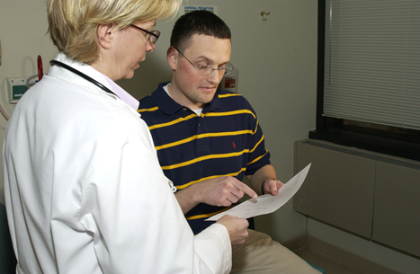 A doctor inquires about a patient's family history. Can extensive stem cell research ultimately provide treatments and cures for diseases previously thought to be "uncurable"? Certainly! (Image Citation 11) |
Parkinson's Disease Cause: Parkinson's disease is caused by slow destruction of the dopamine-producing nerve cells in the brain. Primarily Affects: Sometimes more males than females. The exact ratio varies by country. Discovered By: Dr. James Parkinson Symptoms: Automatic movements (such as blinking) slow or stop, drooling, lack of expression in the face, shaking, tremors, quieter speech, monotone voice, rigid or stiff muscles, confusion, dementia, memory loss, fainting, impaired balance, different muscle aches and pains, etc. Key Statistics:
(Citation 14), (Citation 15), (Citation 16), (Citation 17) |
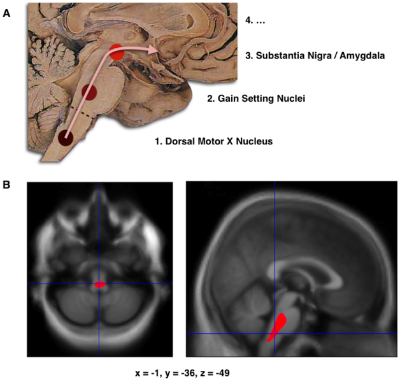 An image showing the onset of Parkinson's Disease. The top part of the image shows the accumulation of alpha-synuclein protein inside Lewy bodies in neurons - this is an initial stage of Parkinson's. The second image shows the brain volume reduction between normal and diseased individuals. Parkinson's, being a neurodegenerative disorder, degrades the central nervous system slowly. |
Alzheimer's Disease Cause: The exact cause of Alzheimer's Disease, or AD is not entirely known, but is thought to include a combination of both genetic and environmental factors. People with particular variations in gene MTHFD1L may be nearly twice as likely to develop a form of late-onset Alzheimer’s disease, the most common kind. Primarily Affects: Equal frequency for males and females. It is generally more prevalent in old age. Discovered By: Dr. Alois Alzheimer Symptoms: Forgetfulness of recent events and conversations, difficulty in multi-tasking, difficulty in solving problems, misplacing entities, language problems, flat mood, change in sleep patterns, difficulty reading or writing, poor judgment, loss of ability to reason or to recognize danger, difficulty doing basic activities, loss of ability to recognize family, inability to understand language, swallowing problems, etc. Key Statistics:
(Citation 18), (Citation 19), (Citation 20), (Citation 21) | 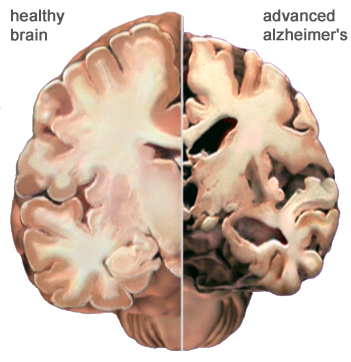 An image showing the physical difference between a normal brain and a brain diagnosed with Alzheimer's. Alzheimer's causes a loss of neurons and synapses throughout the cerebral cortex. (Image Citation 16) 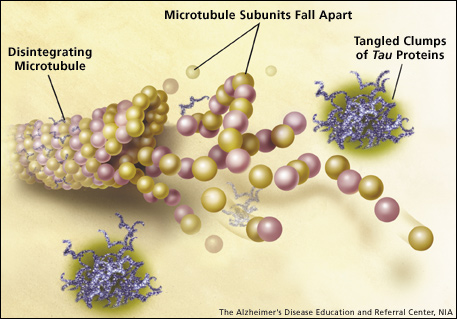 Another image showing degeneration of microtubules (in neurons) at the molecular level. This degeneration on a larger scale ultimately leads to Alzheimer's Disease. (Image Citation 17) |
Aquired Immuno-Deficiency Syndrome (AIDS) Cause: Human Immunodeficiency Virus (HIV) infects cells and lies dormant for a long time. It attacks T-Cells or CD4 cells (immune cells), ultimately destroying these cells and causing AIDS. HIV mainly spreads through exchange of bodily fluids. Primarily Affects: Affects males and females nearly equally. Adolescents are also vulnerable to HIV infection. Discovered By: Dr. Robert Gallo (United States), Dr. Luc Montagnier (France) Symptoms: No specific symptoms. Rather, persons with AIDS may develop opportunistic infections or AIDS related cancers. Because the body lacks immune cells to fight the viruses (due to a large amount of HIV viruses present in the body), severe illness and ultimately, death occurs. Key Statistics:
(Citation 22), (Citation 23) | 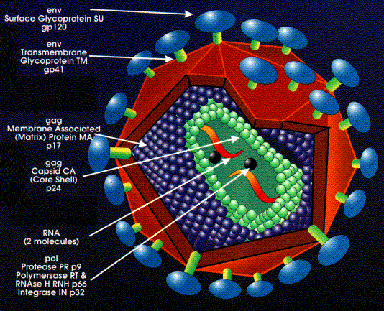 The structure of an HIV virus. HIV infects immune cells drastically, causing a total loss of immune response from the body over time. (Image Citation 18) 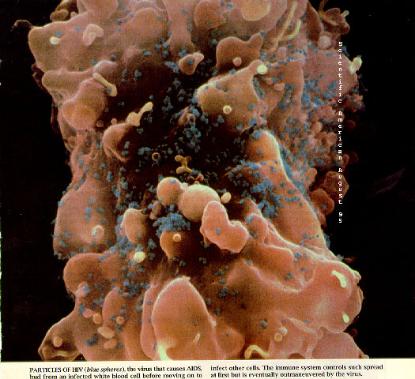 Particles of HIV (the blue spheres) escape from a white blood cell and move on to infect other cells. HIV is very difficult to destroy due to its proliferating and evasive nature. (Image Citation 19) |
Huntington's Disease Cause: A CAG base pair repeat occurs more times than it normally has to on chromosome 4. While normally this section is repeated only 10 to 28 times, in people with Huntington's Disease, the section is repeated 36 to 120 times. Huntington's Disease (or HD) is a neurodegenerative disease. Primarily Affects: Both males and females. As the disease is passed along generations, symptoms develop at younger and younger ages. If a parent has Huntington's, the child has a 50% change of getting the gene responsible for the disease. Discovered By: Dr. George Huntington Symptoms: Behavioral disturbances, hallucinations, irritability, moodiness, paranoia, psychosis, facial movements, slow or uncontrolled movements, quick jerking movements, unsteady gait, dementia, rigidity and tremor (in children). Key Statistics:
(Citation 24), (Citation 25), (Citation 26) | 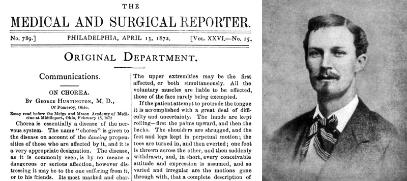 Dr. Huntington (right) and his first article on Huntington's Disease (than known as "chorea"). (Image Citation 20) 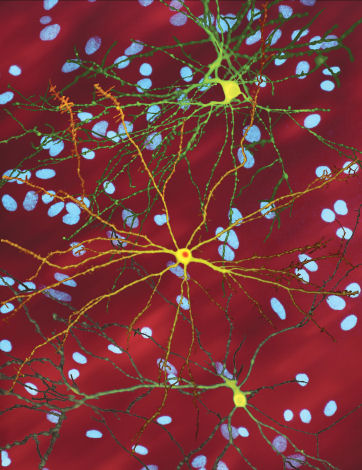 Yellow, medium spiny neurons with orange nuclear inclusions. The development of the inclusions is part of the disease. (Image Citation 21) |
Amyotrophic Lateral Sclerosis (ALS) / Lou Gehrig's Disease Cause: In 10% of cases, ALS is caused by genetic defects. In the remaining cases, the cause is primarily unknown. ALS is a neurodegenerative disease. Primarily Affects: Both males and females, but ALS is 20% more common in men that in women. In addition, 93% of patients in the ALS CARE Database are Caucasian. Notable Researchers: Augustus Waller, Dr. Jean-Martin Charcot Symptoms: Difficuly in breathing, difficulty in swallowing, head drop (due to weakness in muscles), muscle cramps and contractions, paralysis, speech problems, loss of control of muscle movement, weight loss, etc. Key Statistics:
(Citation 27), (Citation 28), (Citation 29) (Citation 30) |  New York Yankees baseball player Lou Gehrig was diagnosed with the disease in 1939. Gehrig's diagnosis brought ALS to the forefront of public attention. (Image Citation 22) 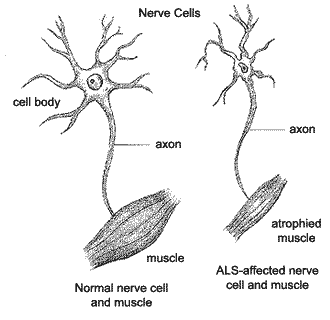 A comparison of a normal nerve cell and muscle and an ALS-affected nerve cell and muscle. The ALS-affected muscle is clearly atrophied. (Image Citation 23) |
Type 1 Diabetes Cause: Type 1 Diabetes occurs when a hormone called insulin (produced by beta cells in the pancreas) is produced in little or no quantity. The exact cause of this is unknown (most likely an autoimmune disorder). Insulin is essential for moving blood sugar, or glucose, into cells. Without enough insulin, instead of going to cells, glucose builds up in the bloodstream. This ultimately leads to symptoms of Type 1 Diabetes. Primarily Affects: Type 1 Diabetes can occur at any age but is most often diagnosed in children, adolescents, and young adults. Discovered By: Ancient Egyptians, Ancient Indian physicians Symptoms: Being very thirsty, feeling hungry or fatigued, having blurry eyesight, losing feeling or feeling tingling sensations in feet, losing weight, urinating more often, deep rapid breathing, dry skin and mouth, nausea, headaches, shaking, sweating, etc. Key Statistics:
(Citation 31), (Citation 32), (Citation 33) | 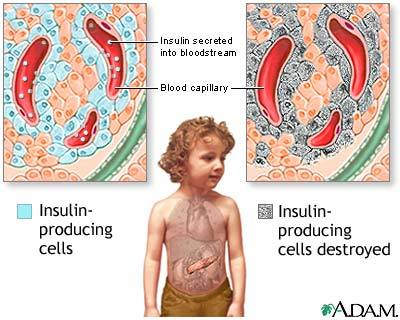 An image showing and comparing the internal physiology/appearance of insulin- producing cells versus insulin-producing cells that have been destroyed. (Image Citation 24) 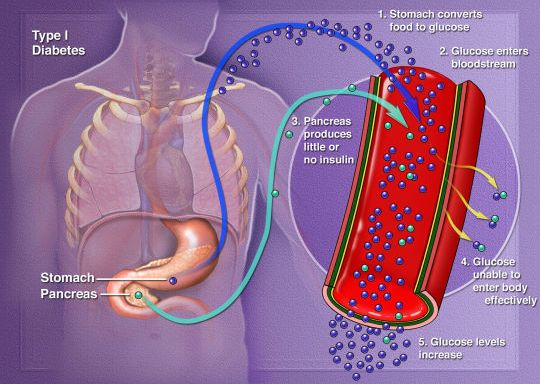 This detailed diagram shows the exact mechanisms of how Type 1 Diabetes occurs when beta cells in the pancreas produce little or no insulin. (Image Citation 25) |
Osteoporosis Cause: Osteoporosis occurs when the body fails to form enough new bone, when too much old bone is reabsorbed by the body, or both reasons. Due to lack of calcium or phosphate, bones and bone tissue cannot develop properly, or as old bone is reabsorbed, the bone tissue becomes weaker, leading to weak or brittle bones. Another leading cause of osteoporosis is drop in level of estrogen in women during menopause, or testosterone level drops in men. Primarily Affects: Women over age 50 and men over age 70. Of those who have osteoporosis, approximately 80% are women and 20% are men. Discovered By: Dr. Astley Cooper, Dr. Jean Lobstein Symptoms: No symptoms occur in the early stages of osteoporosis. Later however, bone pain or tenderness, fractures with little or no trauma, loss of height, stooped posture, neck pain, or lower back pain may occur. Key Statistics:
(Citation 34), (Citation 35), (Citation 36) | 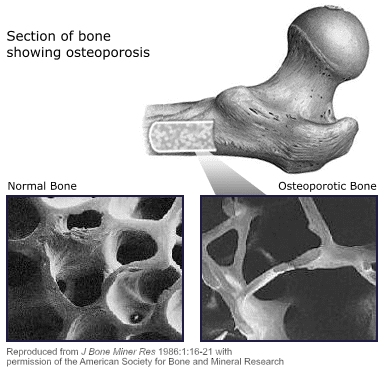 An image showing a section of a normal bone versus a section of an osteoporotic bone. Note the significantly less bone density in the image of the osteoporotic bone. (Image Citation 26)  A visual representation of a normal bone versus an osteoporotic bone. Osteoporosis represents a major health risk for numerous individuals. (Image Citation 27) |
Myocardial Infarction (Heart Attack) Cause: Myocardial Infarctions, or heart attacks, are caused by a blood clot which blocks the coronary arteries (arteries responsible for bringing blood and oxygen to the heart). The clot/blocking occurs due to a buildup of plaque or other cells. Heart attacks are classified as emergencies and may be potentially fatal. Primarily Affects: Both males and females. Symptoms: Chest pain (extreme, feeling like a pressure or tight band), anxiety, cough, fainting, dizziness, nausea, palpitations, shortness of breath, heavy sweating. Some persons, such as elderly individuals or women, have little or no chest pain. In "silent" heart attacks, no symptoms occur. Key Statistics:
(Citation 37), (Citation 38), (Citation 39) | 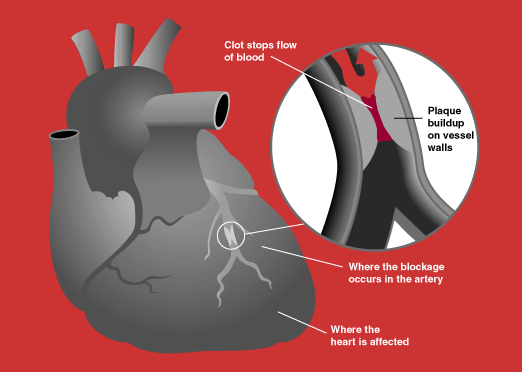 A simple illustration of a myocardial infarction, or heart attack. Heart attacks occur in almost 785,000 Americans each year. (Image Citation 28) 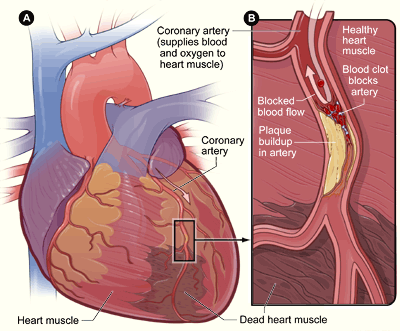 A more detailed diagram of a heart attack, showing plaque buildup in the artery and a comparison of dead heart muscle to healthy heart muscle. Blood clots do not allow oxygen-rich blood to freely flow. (Image Citation 29) |
Burns Cause: Burns are caused by contact of human skin with heat of varying degrees. They cause a significant damage of skin or tissue, and may be accompanied by other infections. First Degree Burns: Burns which only affect the outer layer of skin, causing some pain, redness, or swelling. Second Degree Burns (partial thickness): Burns which affect both the outer and inner layers of skin, causing pain, redness, swelling, and blistering. Third Degree Burns (full thickness): Burns which extend into more deeper tissues. They cause whitened or blackened charred skin which may feel numb. Primarily Affect: Both males and females. Symptoms: Blisters, peeling and/or red skin, pain (at very high degree burns, pain does not sometimes occur), swelling, shock, white or black charred skin. Key Statistics:
(Citation 40), (Citation 41) | 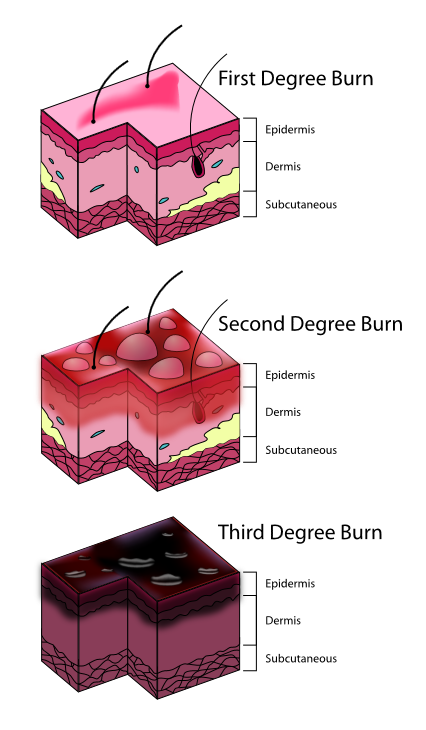 A diagram showing the various degrees of burning that can occur on human skin, with varying exposures of temperature and time. Burn injuries account for approximately 45,000 hospitalizations in the United States each year. (Image Citation 30) |